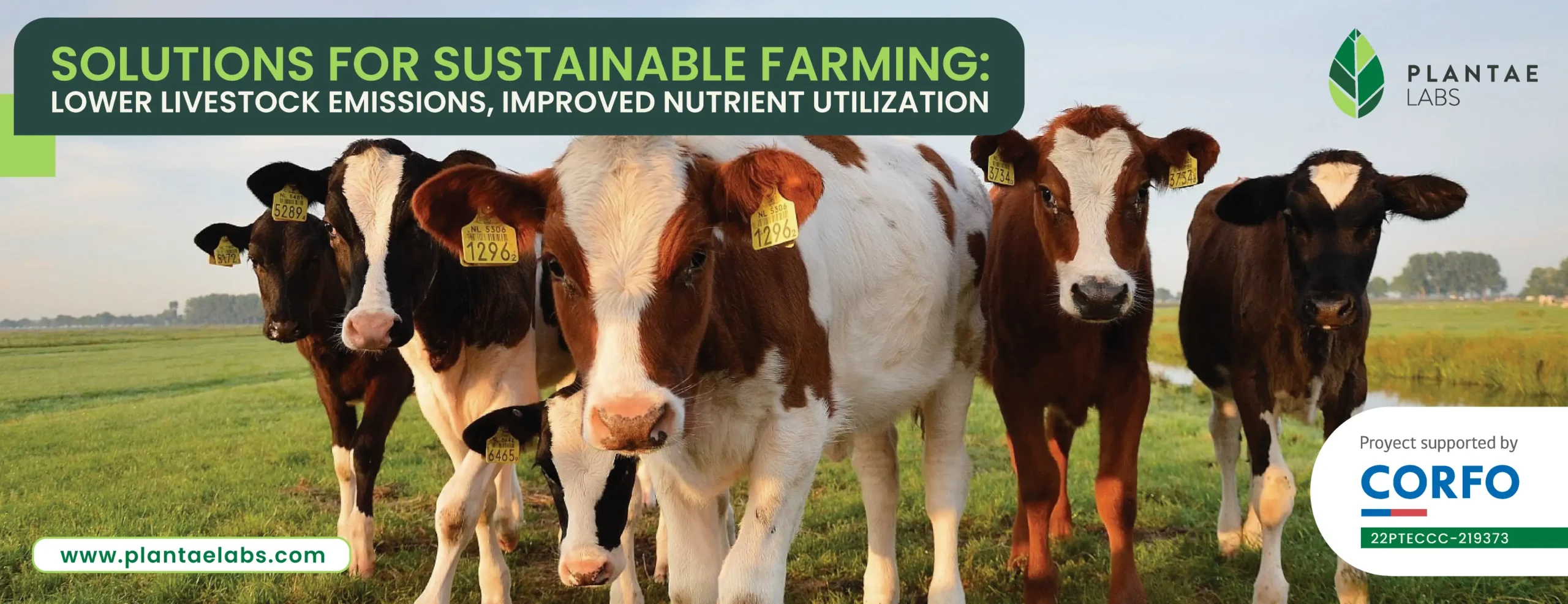Modern ruminant feeding involves complex interactions that impact both productivity and environmental footprint. Feed additives like phytogenics have emerged as a promising approach to balance these outcomes. As part of the CORFO project: 22PTECCC-219373, this study delved into the properties of our Quillaja formulation, to address challenges in livestock emissions. The project aligns with global sustainability goals by offering cutting-edge solutions for reducing methane and ammonia emissions while enhancing nutrient absorption and productivity in ruminants.
Process Overview:
Rumen fermentation is a crucial process for nutrient digestion in ruminants. The rumen harbors a diverse microbial ecosystem that works symbiotically to degrade fiber and carbohydrates into volatile fatty acids (VFAs). At the same time, this process generates large amounts of greenhouse gases, like methane and ammonia, which contribute to climate change and intensify challenges for farm management.

Phytogenic feed additives are used by ruminant producers to optimize nutrient utilization, improve gut health, and reduce emissions, particularly methane (CH₄) and ammonia (NH₃). These additives can enhance livestock performance, such as body weight gain and feed conversion ratios. However, many current solutions face challenges, including high treatment costs and potential declines in productive parameters. Sustainable sourcing and production are also key for responsible livestock management.
Quillaja’s Role: Our natural solution
Our Quillaja proprietary solution has shown promising potential in addressing these emissions challenges. By optimizing nutrient absorption, reducing methane and ammonia emissions, and improving gut health, Quillaja offers a sustainable solution for livestock production. Below, we explore how Quillaja saponaria works to mitigate these emissions, supported by scientific research and real-world applications.
Mechanisms of Saponins in Methanogenesis
Methane is produced by methanogenic archaea during enteric fermentation, while ammonia results from the breakdown of nitrogen in feed. Many factors impact CH4 production, such as the basal diet, microbial populations, and interactions between feed composition and the microbiota. Managing these emissions is complex, as reducing methanogenesis could disrupt the fermentation pathway and thus reduce the major energy source for ruminants. Consequently, evaluating the response of rumen fermentation to feed additives is crucial for balancing performance and environmental impact.
Saponins, natural surface-active compounds, are thought to disrupt methanogenesis by targeting methanogenic archaea—microorganisms critical to methane production. Their amphipathic structure may interfere with archaea cell membranes, potentially reducing their activity.

Mechanisms:
- Membrane Disruption: Saponin-cholesterol interactions compromise cell membrane integrity (Fleck et al., 2019).
- Microbial Modulation: Saponins reduce cellulolytic bacteria and fungi, limiting hydrogen availability for CH4 formation (Jayanegara et al., 2014).
Methodology: Rumen Simulation for Real-World Insights
Using the Rumen Simulation Technique (RUSITEC), our study simulated the ruminal fermentation environment to evaluate the impact of Quillaja saponins on emissions and nutrient utilization efficiency.

Credit: Professor Jorge Ávila, University of Concepción.
Results: Emissions and Productivity Improvements
Emission Reductions:

The trials demonstrated significant reductions in methane and ammonia emissions, highlighting the environmental benefits of using our proprietary solution for responsible livestock farming.
The inclusion of our Quillaia extract led to shifts in VFA profiles, notably increasing propionate and reducing acetate and butyrate levels. Propionate is a key volatile fatty acid that enhances energy availability and improves feed efficiency, supporting high milk yields and overall cow productivity (Duplessis et al., 2017)
Volatile Fatty Acid (VFA) Profiles:
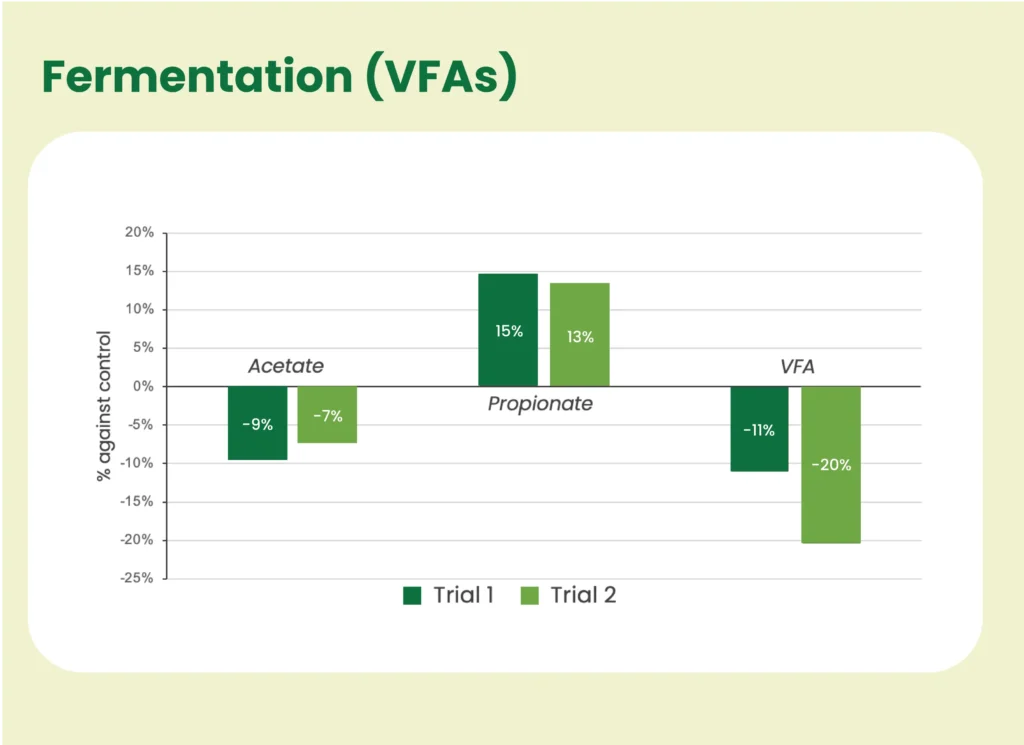
Kim et al. (2022) found that reducing excessive acetate levels in the rumen can prevent metabolic disorders like acidosis. This reduction helps maintain a more balanced fermentation environment, ultimately supporting healthier rumen function and reducing the risk of acidosis in lactating cows. Additionally, the reduction in butyrate, with values between 3% and 7% in the first and second study, respectively, further indicates a healthier rumen environment.
These shifts promote better energy efficiency, crucial for optimizing feed utilization, improving livestock health, and reducing waste in the system.
Digestibility Metrics:
While dry matter digestibility (DMD) remained stable, the trials showed increased fiber disappearance and protein availability. These improvements contribute to better feed efficiency and overall livestock performance.

Comparison with Alternatives
When compared to other feed additives like chestnut tannins, our Quillaia extract demonstrated strong performance, particularly in reducing methane and ammonia emissions. As shown in the graphic below, our solution significantly reduced both methane (CH₄) and ammonia (NH₃) emissions, achieving similar or better results at a lower dose, which makes it a more cost-effective option.

Regarding VFA profiles, both Quillaia and Chestnut reduced total VFA and the A:P ratio. However, our formula showed a more favorable balance, promoting better energy efficiency while mitigating harmful compounds, indicating a more sustainable solution for livestock production.
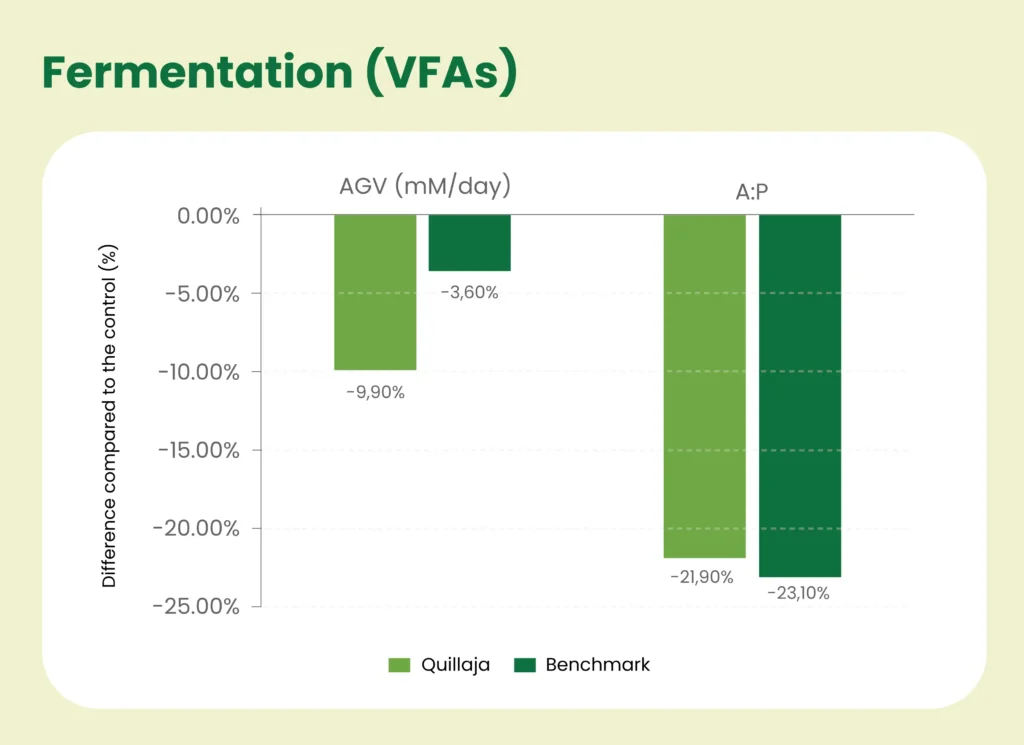
The Digestibility highlights our Quillaja formula’s positive impact on nutrient utilization. It led to a smaller reduction in dry matter intake (DIVMS) compared to chestnut tannins. Additionally, Quillaia improved in vitro fiber and protein disappearance, while chestnut tannins showed negative effects.
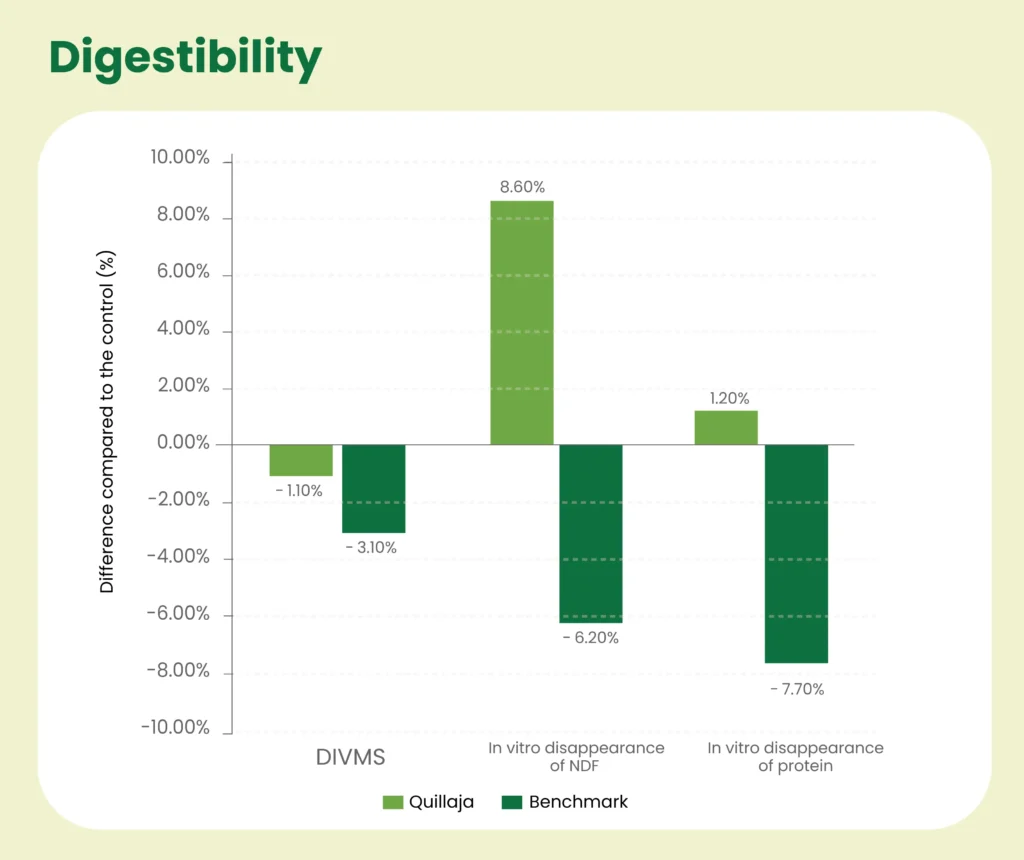
These results demonstrate that our proprietary solution not only reduces emissions but also enhances nutrient digestibility, offering an advantage in improving feed efficiency and livestock performance.
Positioning Quillaja After Results
The study shows that our proprietary Quillaia solution reduces methane and ammonia emissions, enhances feed efficiency, and supports sustainable livestock farming. Notably, Quillaja saponaria achieves these results with lower doses compared to other additives, making it a more economical option for farmers. This enhanced efficiency, combined with its environmental benefits, positions our Quillaia-based solution as a key strategy for sustainable and cost-effective livestock production.
Ready to improve your livestock’s efficiency while reducing emissions? Connect with us today to learn how our Quillaia solutions can support your sustainability goals.
References:
- Fleck, J. D., Betti, A. H., Da Silva, F. P., Troian, E. A., Olivaro, C., Ferreira, F., & Verza, S. G. (2019). Saponins from Quillaja saponaria and Quillaja brasiliensis: Particular Chemical Characteristics and Biological Activities. Molecules, 24(1), 171. https://doi.org/10.3390/molecules24010171
- Jayanegara, A., Wina, E., & Takahashi, J. (2014). Meta-analysis on methane mitigating properties of saponin-rich sources in the Rumen: influence of addition levels and plant sources. Asian-Australasian Journal of Animal Sciences, 27(10), 1426–1435. https://doi.org/10.5713/ajas.2014.14086
- Kim, S. H., Ramos, S. C., Valencia, R. A., Cho, Y. I., & Lee, S. S. (2022). Heat stress: effects on rumen microbes and host physiology, and strategies to alleviate the negative impacts on lactating dairy cows. Frontiers in Microbiology, 13. https://doi.org/10.3389/fmicb.2022.804562
- Duplessis, M., Lapierre, H., Ouattara, B., Bissonnette, N., Pellerin, D., Laforest, J., & Girard, C. (2017). Whole-body propionate and glucose metabolism of multiparous dairy cows receiving folic acid and vitamin B12 supplements. Journal of Dairy Science, 100(10), 8578–8589. https://doi.org/10.3168/jds.2017-13056

